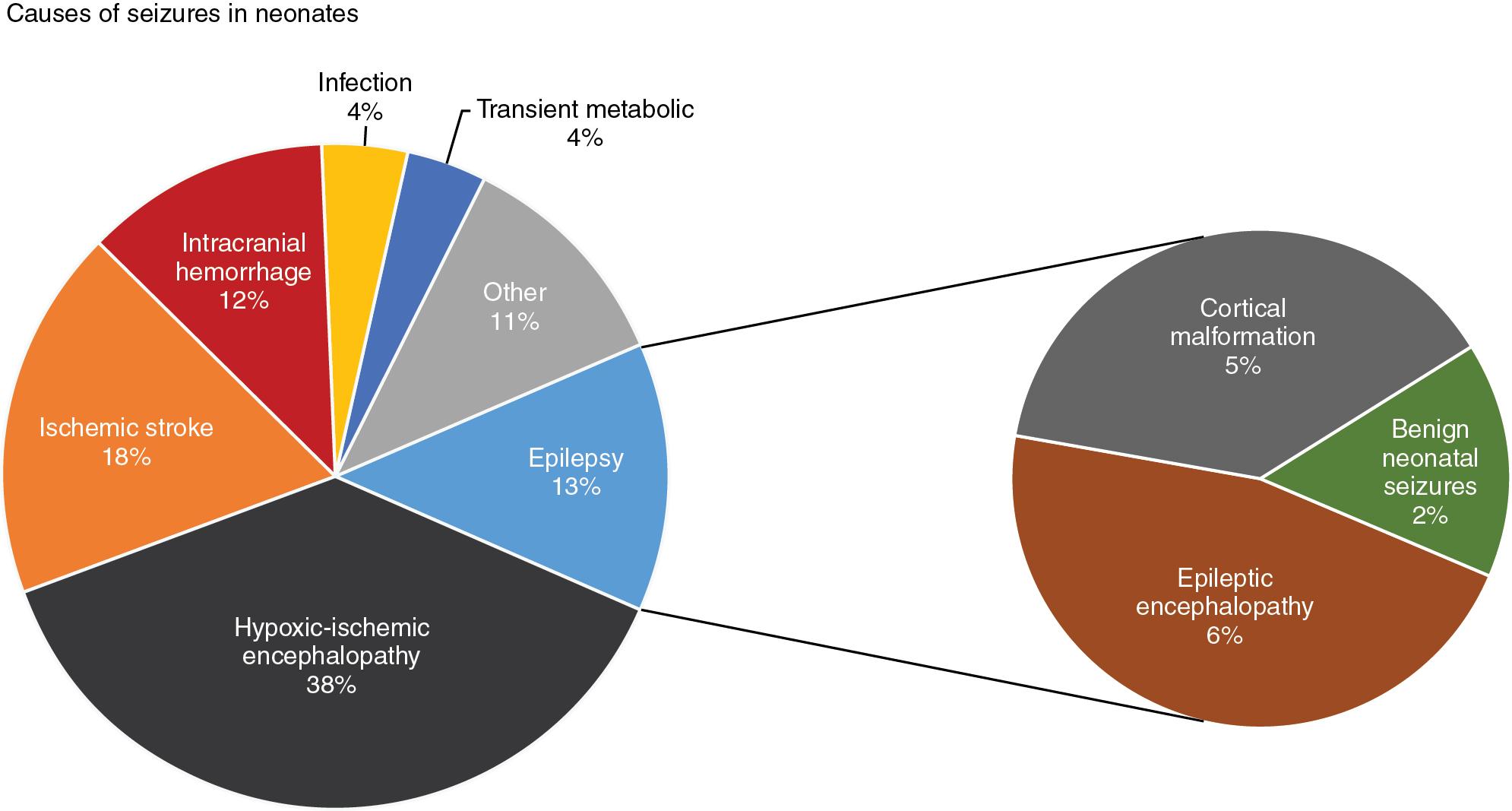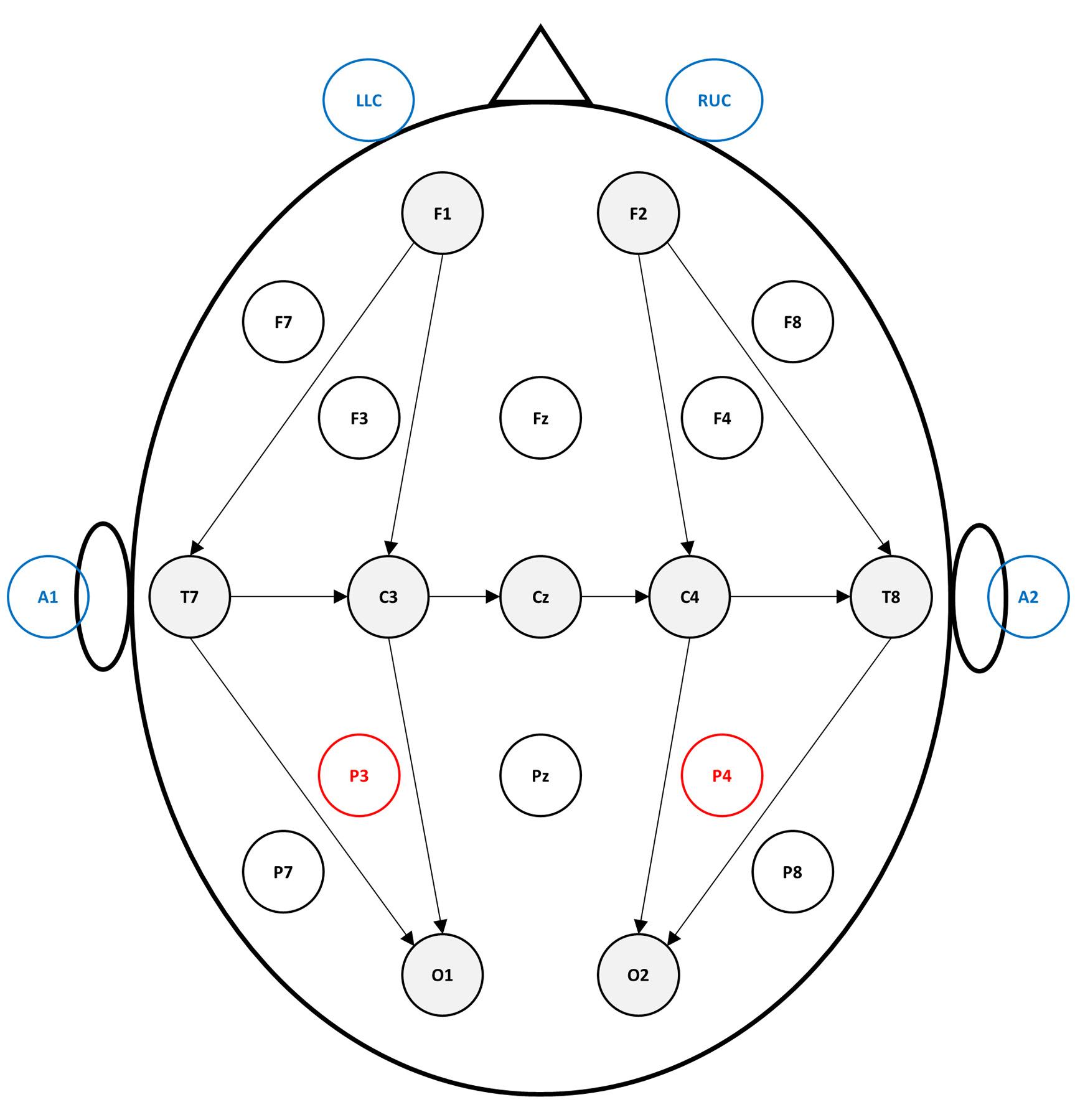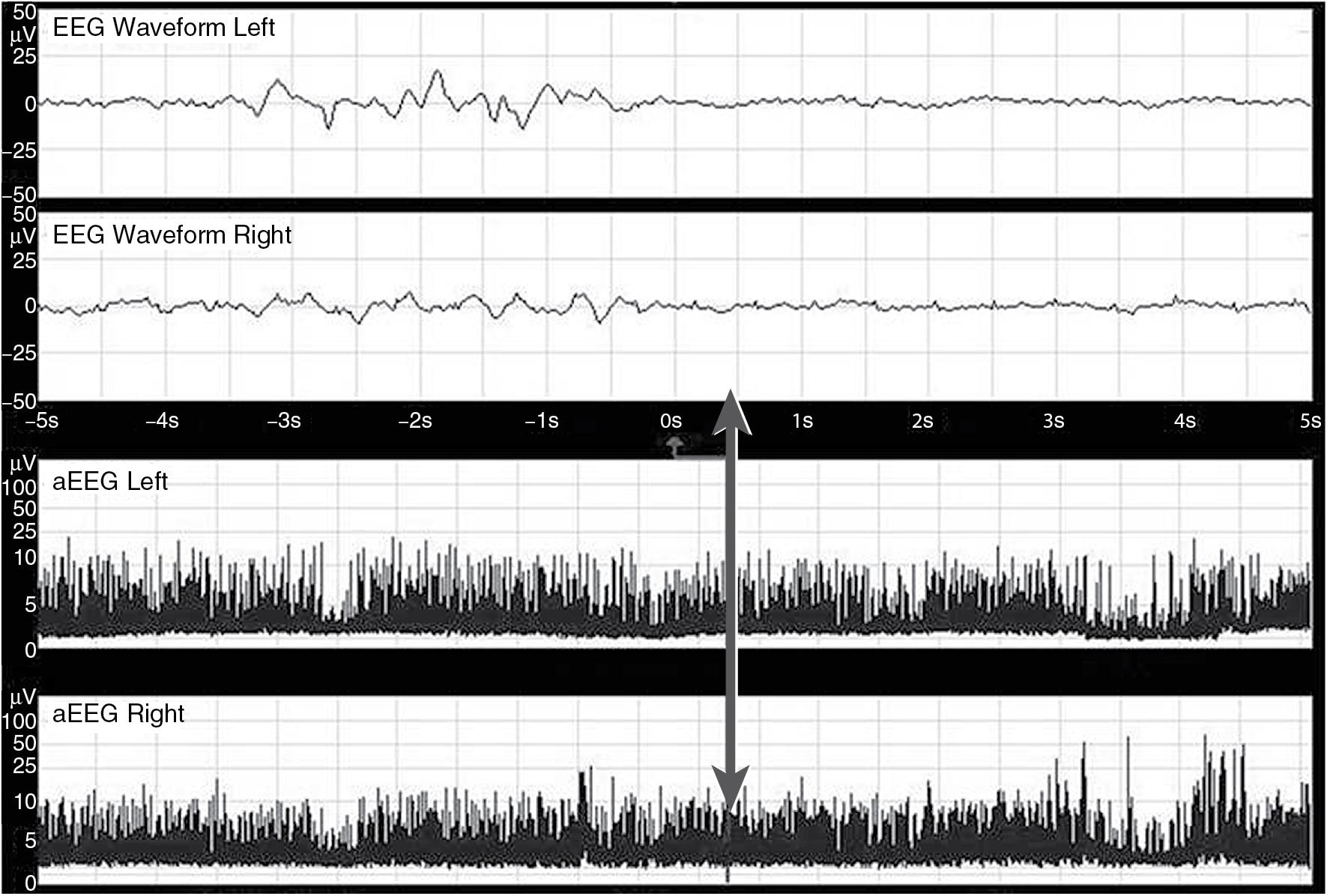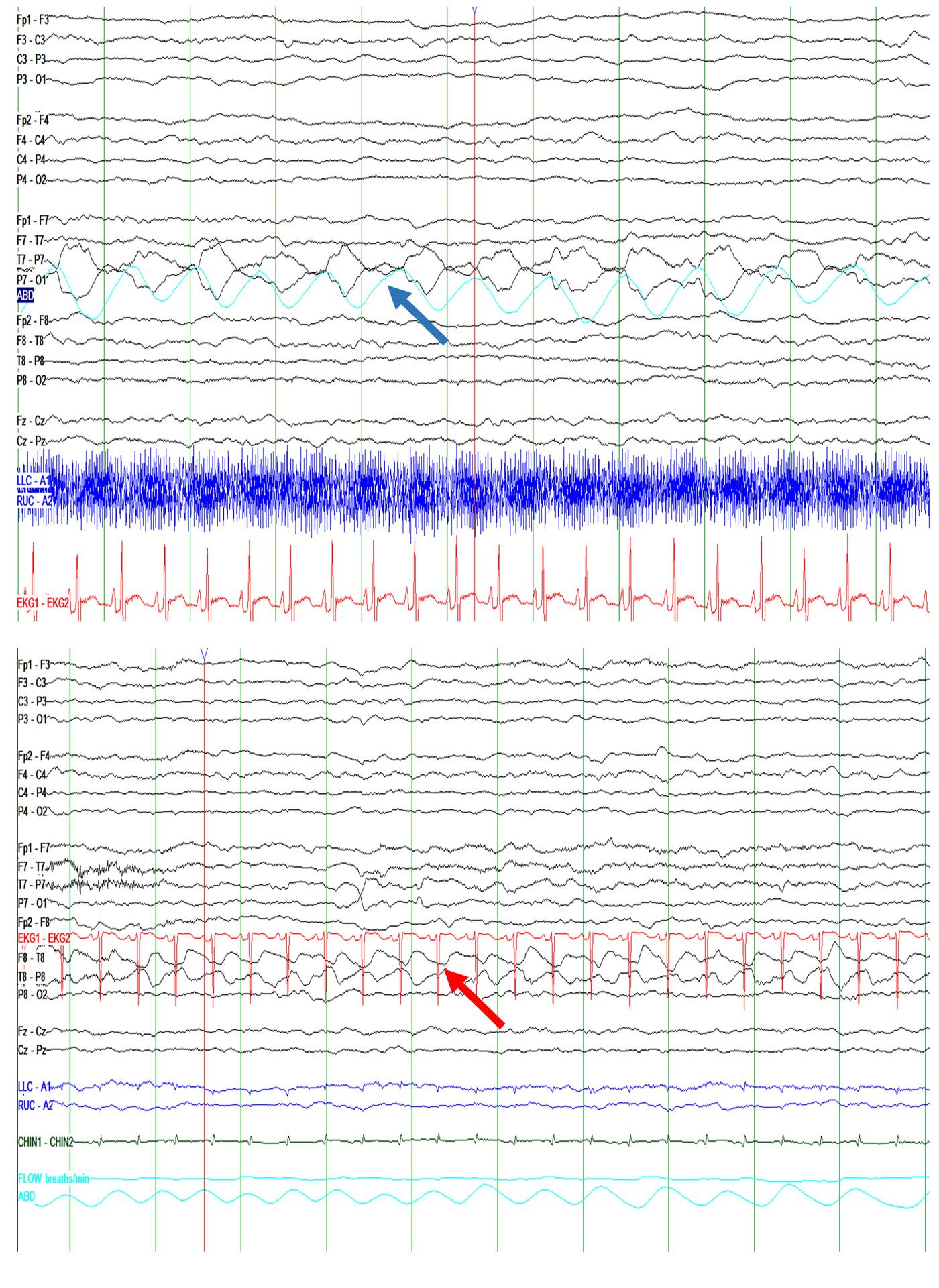Physical Address
304 North Cardinal St.
Dorchester Center, MA 02124
![]() Benign Neonatal Seizure
Benign Neonatal Seizure
Seizure incidence is at its highest in the neonatal period, estimated at 1 to 3 per 1000 term neonates and 10 times higher for preterm/low birth weight newborns ( ). Most cases are considered acute symptomatic seizures, result from acute brain injury, and occur in its immediate aftermath ( Fig. 19.1 ). The underlying etiologies for acute symptomatic seizures in neonates include hypoxic ischemic encephalopathy (38%), ischemic stroke (18%), and intracranial hemorrhage (12%). Transient metabolic derangements (4%) and central nervous system infection (4%) are other less common etiologies. Epilepsy, defined as recurrent unprovoked seizures, is responsible for less than 15% of newborns with seizures ( ). However, early identification carries important prognostic and therapeutic implications because the evaluation and management of neonatal-onset epilepsies is distinct from that of acute symptomatic seizures ( ). Neonatal epilepsy is largely genetic in origin, including dominantly inherited neonatal epilepsy (15%), epileptic encephalopathy (46%), and malformations of cortical development (39%), which often result from somatic mutations ( ).

The timing of seizure onset in newborns may hint at the cause. Hypoxic ischemic encephalopathy often presents with seizures in the first 12 to 24 hours after birth. Seizures resulting from central nervous system infection or hemorrhage can present later, even weeks after birth. With perinatal stroke, seizures commonly present within 24 to 48 hours following birth ( ) but may occur later in infancy. Seizures secondary to intraventricular hemorrhage in preterm neonates usually present in the first week of life.
Intracranial hemorrhage can present with seizures in newborns depending on the location and type of intracranial hemorrhage. Epidural hemorrhage is rare in newborns but always follows a traumatic event. Subdural hemorrhage is the most common type of intracranial hemorrhage in neonates; it is caused by traumatic delivery but does not usually present with seizures unless there is injury to the underlying cortex ( ). Cerebral parenchymal hemorrhage involving cortical and/or subcortical gray matter commonly presents with seizures.
Metabolic derangements such as hyponatremia, hypocalcemia, and hypoglycemia can also result in acute seizures within the first days of life. Although most of these are transient in nature, all metabolic derangements should be investigated to make sure there are no congenital or acquired liver, renal, or endocrine abnormalities.
Central nervous system infection is less common than it had been in the past. Seizures associated with central nervous system infections may present as late as several weeks of age and can result from bacterial, fungal, or viral infections (e.g., herpes simplex virus, parechovirus, etc.).
Although insufficient by itself for diagnosis, the clinical manifestation of seizures—the seizure semiology—can provide clues regarding etiology that may complement the clinical history, examination, electroencephalography (EEG), and neuroimaging ( Table 19.1 ). For example, perinatal ischemic stroke in neonates is relatively common at 1 to 2 per 1000 live births, most often affects middle cerebral artery territory (left more often than right), and may present as contralateral focal-clonic seizures. Stroke is thought to result from embolism from the umbilical cord or placenta; the majority of babies do not have a coagulopathy and are at low risk for recurrence. Newborns with stroke do not manifest hemiparesis, as corticospinal tracts are not yet used for movement, and the baby is often otherwise well appearing with seizures as the only symptom of brain injury.
| Diagnosis | Seizure Type | Clinical Examination | EEG Background |
|---|---|---|---|
|
|
|
|
|
|
|
|
|
|
|
|
|
|
|
|
|
|
|
|
|
|
|
|
Acute symptomatic seizures in neonates are focal in onset, and seizure spread to adjacent locations or rest of the brain is uncommon. Because they may not propagate sufficiently to result in any clinical manifestation, the clinical diagnosis of the seizures is limited. Moreover, when medication is used to treat seizures it often results in an uncoupling, in which the electrographic seizure continues even after clinical manifestation ceases, a phenomenon referred to as electroclinical dissociation. For these reasons, surveillance in populations at high risk for seizures represents a major indication for continuous EEG monitoring. Patients are considered high risk either because they have known or suspected brain injury (e.g., hypoxic–ischemic encephalopathy, etc.) or because they are at high risk for brain injury (e.g., on an extracorporeal membrane oxygenation [ECMO] circuit) ( Table 19.2 ). For example, approximately 50% of patients undergoing therapeutic hypothermia for hypoxic ischemic encephalopathy (HIE) have seizures ( ). These seizures are typically subclinical or become so during the clinical course ( ). Congenital heart disease is another high-risk group, with approximately 10% of this population affected by (mostly subclinical) seizures ( ).
| Indication | Example |
|---|---|
| Paroxysmal spells of uncertain nature | 2 day-old full-term boy with recurrent unexplained episodes of apnea |
| Neonatal encephalopathy of unknown etiology | 34-week female with unremarkable prenatal course and delivery, but with Apgar scores of 1 and 8; examination notable for encephalopathy with poor visual attention, hypotonia, and reduced spontaneous movements |
| Congenital heart disease | 10-day-old boy with hypoplastic left heart syndrome, status post Norwood procedure |
| Extracorporeal membrane oxygenation (ECMO) | 2-week-old girl with truncus arteriosus, status post repair complicated by cardiac arrest and now on veno-arterial ECMO |
| Hypoxic–ischemic encephalopathy | 37-week male child undergoing therapeutic hypothermia after birth by emergency C-section for nonreassuring fetal heart tracings in the setting of placental abruption |
| Stroke (ischemic infarction or intracranial hemorrhage) | Female neonate born at 29 weeks, found on screening ultrasound during the first week of life to have a left-sided periventricular hemorrhagic infarction (Grade IV intraventricular hemorrhage) |
| Meningoencephalitis suspected/known | Febrile neonate, alternately lethargic and irritable with episodes of opisthotonic posturing and blood cultures positive for gram-negative rods |
| Genetic disorder associated with epilepsy suspected/known | Male newborn born at 37 weeks with antenatal imaging notable for multiple cardiac rhabdomyomas concerning for Tuberous Sclerosis Complex |
| Cortical malformation | 38-week male neonate born without complications; antenatal course concerning for lissencephaly, confirmed on fetal MRI |
Although we have dichotomized acute symptomatic seizures and neonatal-onset epilepsy, it is important to realize that acute brain injury can, and indeed may be relatively more likely to, occur in the setting of encephalopathy related to other causes resulting in a dual diagnosis. Caution is urged as well in settling on a diagnosis when the history is not entirely consistent or definitive, as false attribution is common. Many patients with epileptic encephalopathies are initially diagnosed with HIE.
The temporal evolution of acute symptomatic seizures in newborns is not uniform. Seizure burden often reaches a peak at around 23 hours after birth in newborns with HIE. The median time from first recorded seizure to maximum seizure burden is 5.9 hours ( ). Individual neonatal seizures are rarely prolonged. Most neonatal seizures last less than 90 seconds. Therefore neonatal status epilepticus is defined as the presence of electrographic seizures during at least 50% of a 1-hour EEG epoch.
The diagnostic workup should include investigation of the maternal and family history (e.g., previous pregnancy losses, family history of neonatal seizures), prenatal course (e.g., reduced fetal movements, substance abuse), the events surrounding labor and delivery (e.g., sentinel events such as placental abruption), and the immediate postnatal clinical course (e.g., Apgar scores, need for and duration of resuscitation). The general examination should note vital signs; growth parameters including head circumference, length, and weight; palpation and auscultation of the anterior fontanelle; a thorough skin inspection; and cardiovascular examination. Careful attention to the presence of dysmorphic faces, malformations affecting the digits, and genitals is also required.
Seizures localize to the cerebral cortex, but the neurologic examination of newborns rostral to the brainstem is very limited because of developmental considerations (e.g., motor movements are not directly cortically generated in the newborn period). Abnormal functioning of the cerebral cortex in neonates may manifest on examination in the following ways:
Encephalopathy (excessive irritability, poor visual attention, lethargy, stupor, or coma) assessed by responses to sensory stimuli (visual cues, sound, touch, pain) and elicitation of sucking response and other primitive reflexes
Abnormal tone is an additional sensitive but indirect and nonspecific sign of nervous system dysfunction; it may be reduced overall or extensor tone may be abnormally high compared with flexor tone (e.g., opisthotonic arching in an irritable baby with kernicterus or meningitis)
Spontaneous movement is often reduced with injury to the cerebral cortex in the acute setting, though asymmetry and true weakness point to peripheral nervous system involvement
Seizures in newborn infants can be the first sign of serious neurologic disease or systemic illness. Abnormal paroxysmal events in a neonate should prompt an emergent evaluation. It is important to note, however, that although most neonatal seizures are subclinical and can only be diagnosed accurately by electroencephalography (EEG), it is also true that most abnormal neonatal movements have no EEG correlate and thus are not seizures. Even the most experienced clinicians may misdiagnose unusual paroxysmal events as seizures. Even if not seizures, abnormal episodes may reflect CNS dysfunction (e.g., opisthotonic posturing is not a seizure but is very abnormal). Accurate differentiation of neonatal seizures and nonseizure events is critical, both to ensure adequate treatment for infants with seizures and to avoid administering anticonvulsants to those whose events are not seizures.
Before the era of continuous EEG monitoring, seizures were identified clinically and categorized as tonic, clonic, myoclonic, or subtle (e.g., bicycling, apnea, abnormal eye movements) ( ). Subsequently, it has been shown that clinical observation used in isolation to diagnose seizures is inadequate because of:
Poor specificity, as many paroxysmal behaviors in newborns are unaccompanied by electrographic correlate on EEG ( )
Poor sensitivity, as seizures are very often subclinical, lacking consistent clinical features ( )
Poor agreement between observers ( )
A 3500 g male infant was delivered at 39 weeks’ estimated gestational age to a 28-year-old primigravida mother after a pregnancy complicated only by maternal group B streptococcal colonization. His mother received antibiotic prophylaxis with clindamycin during labor because of an allergy to penicillin. The infant was delivered vaginally and appeared healthy, with a normal physical examination. He was cared for in the well-baby nursery and discharged to home with his mother after 36 hours.
One week later, he developed unusual episodes characterized by brief, sudden, jerking movements of his arms and legs. These occurred in clusters lasting between 1 and 5 minutes while he was sleeping. Between events, he fed normally.
At his pediatrician’s office, the baby was slightly lethargic and weighed 3600 g. His head circumference was 35.5 cm and his vital signs were normal. While he was sleeping in his mother’s arms, he suddenly developed a tonic stiffening of his left arm, followed by arrhythmic movements of his left leg and then the right arm. The pediatrician lifted him to the examination table and undressed him. The infant cried and the movements ceased, but he exhibited brief periods of apnea.
A 30-week gestational age infant was transferred from a referring hospital for evaluation of intraventricular hemorrhage. He has depressed mental status and is intubated and sedated. A brain magnetic resonance imaging (MRI) is scheduled in 2 hours.
A 39-week gestational age infant was delivered to a 30-year-old multiparous mother who admits to polysubstance abuse during the pregnancy. The infant is now 2 days old and she is jittery and has frequent episodes of full-body stiffening and crying. Blood and cerebrospinal fluid (CSF) cultures are negative.
Options for diagnosis of neonatal seizures include bedside (clinical) observation, routine-length electroencephalography (EEG), conventional video-EEG monitoring, and amplitude-integrated EEG.
For each of the preceding cases, decide if the infant is having seizures and which (if any) electrodiagnostic test (conventional [routine length] EEG, amplitude integrated EEG, or video-EEG) is indicated.
The infant in Case Study 1 is at very high risk for sepsis and meningitis, which raises concern for acute symptomatic seizures. Clindamycin is not considered adequate intrapartum prophylaxis. The episodes of apnea could be ictal or could be unrelated to seizures. The episode of tonic stiffening of the left arm may be a focal seizure. The depressed mental status could be accentuated by subtle or subclinical seizures. The best, most appropriate testing for this neonate is conventional video-EEG monitoring. If no seizures are recorded, and the EEG background remains stable, then monitoring can be discontinued after 24 hours. If seizures are identified on the EEG, then monitoring should continue until the infant remains seizure-free for 24 hours.
The neonate in Case Study 2 is at high risk for seizures due to the intracranial hemorrhage. He has depressed mental status, which raises concern for subclinical status epilepticus. However, he will need to be transported to MRI in 2 hours and cannot have EEG leads in place during the MRI scan, because the leads contain metal. In this case using amplitude-integrated EEG to screen for status epilepticus before he is transported to MRI is a reasonable option. Conventional EEG monitoring can begin after the MRI.
The infant in Case Study 3 likely has neonatal abstinence syndrome. Although this raises the risk for neonatal seizures, the events of concern are not focal, which lessens the chances that they represent seizures. The episodes are occurring very frequently, so they are likely to be captured during a conventional EEG. If several (three or four) typical events are recorded and are not seizures, and the EEG background is normal or nearly normal, then the EEG may be discontinued.
The diagnosis of neonatal seizures is made based on clinical findings and EEG. When seizures are suspected, multiple facets of evaluation and treatment must occur simultaneously: (1) accurate diagnosis of the events of concern (e.g., seizure versus nonepileptic paroxysmal event), which is most accurately characterized by EEG; (2) determination of the etiology of the events of concern (e.g., sepsis, electrolyte abnormalities, acquired or congenital brain abnormalities); and (3) empiric treatment of the most likely etiologies (e.g., antibiotics, adequate hydration). Here, we discuss characterization of the events of concern first, but in clinical practice an additional diagnostic evaluation and treatment occur in tandem.
Continuous video-EEG monitoring in neonates is polygraphic and records cerebral activity from the scalp ( Fig. 19.2 ), the heart (electrocardiogram, ECG), eye (electrooculogram, EOG), muscle (electromyogram, EMG), and respiration for the purposes of recording common sources of noncerebral artifacts and determination of behavioral state. The rationale for detecting electrographic seizures rests on the assumption that detection and treatment will ultimately lead to improvement in clinical outcome. Conventional (routine length) EEG remains the gold standard for seizure detection in neonates. Most acute symptomatic seizures (50%–80%) in neonates are subclinical—they have no externally apparent manifestations. Subclinical seizures are discrete electrographic events, distinct from the EEG background, that evolve in location, morphology, and/or frequency, lasting at least 10 seconds ( Fig. 19.3 ). An electroclinical seizure is an abnormal electrographic change time locked to clinical features. Episodes that have no associated correlate on EEG should not be considered seizures.


As inaccurate diagnosis is expected to lead to untreated seizures on the one hand and inappropriate use of antiepileptic drugs on the other, the World Health Organization’s Guideline on Neonatal Seizures strongly recommends that all clinical seizures be confirmed by EEG where available ( ). Characterization of paroxysmal events in neonates is one of the major indications for video-EEG monitoring. In addition to capturing any clinical features associated with seizure activity, video can assist with the diagnosis of other benign or abnormal phenomena (e.g., sleep myoclonus, jitteriness, opisthotonos) or other neurologic diagnoses (e.g., hyperekplexia, paroxysmal extreme pain disorder).
Amplitude-integrated EEG (aEEG) displays a transformed signal from a 2 to 15 Hz frequency window usually recorded with two electrodes, typically parietal ( Figs. 19.3 and 19.4 ), on a compressed timescale. The aEEG provides monitoring that can be interpreted at the bedside at a sacrifice of sensitivity, given coverage and technical limitations ( ; ; ). There is also the potential for false positives, as artifact is more likely to successfully masquerade as seizures in the absence of polygraphic recording ( Fig. 19.5 ). Seizures suspected on aEEG should be confirmed with conventional EEG recording.


A recently published expert commentary suggests that prolonged conventional video-EEG provides the best opportunity for the correct identification of seizures and is essential for the detection of the neonatal seizures ( ). With aEEG the chance to detect seizures accurately remains at only 12% and sensitivity increases with the longer seizure duration ( ). For instance, if a seizure duration is less than 2 minutes, the sensitivity of aEEG for seizure detection is only 13%. However, it is 65.5% for a duration between 5 to 10 minutes and 81% for seizures lasting more than 10 minutes. The limited ability to detect seizures using aEEG is because seizure durations are often short, seizure amplitudes are lower, seizure location may not be close to the aEEG leads, and of inadequate training of aEEG readers.
In addition to characterization of paroxysmal events and detection of subclinical seizures in at-risk populations, the EEG itself provides a quantitative measure of cerebral cortical dysfunction (i.e., encephalopathy) to complement the clinical assessment of mental status and may even highlight specific areas of injury ( Box 19.1 ). In sedated and/or paralyzed patients, EEG may provide the only means of examining central nervous system function. In addition, the EEG background and its evolution over time may be predictive of outcome in the setting of acute brain injury. For example, in the setting of HIE, a severely abnormal EEG background (e.g., burst suppression, extreme low voltage) is predictive of adverse neurodevelopmental sequelae ( ), whereas normalization of the EEG within the first 36 hours is a positive prognostic indicator ( ). Amplitude-integrated EEG can be a useful screening tool for detecting background abnormalities.
The neonatal EEG is characterized by quantitative and qualitative features that evolve from week to week across a continuum of pre- and postnatal development. A given finding may be normal or abnormal depending on the gestational age, and inaccuracies in dates can affect interpretation.
Discontinuity – Higher voltage “bursts” interrupted by periods of lower amplitude, “interburst intervals” (IBIs); discontinuity is a normal feature of neonatal EEG with burst and IBI duration, voltage and synchrony characteristic for different states at different gestational ages; discontinuity is abnormal if in excess of these parameters for age (i.e., “dysmature”)
Voltage – The normal EEG background is symmetric, with characteristic amplitude ranges in different states at different gestational ages; voltage may be low diffusely or focally in the setting of cortical injury or artificially reduced by any process that increases the distance between the brain and recording electrodes (e.g., scalp edema, subdural hemorrhage); persistent low voltage without variability or normal features is a severely abnormal background
Variability – Normal changes in the EEG over the recording period; spontaneous variability includes state changes; reactive variability refers to changes provoked by stimulation (auditory, tactile, etc.)
Burst suppression – Severe invariant discontinuous EEG background with long flat IBIs and bursts lacking identifiable graphoelements
Activité moyenne – Continuous low-moderate voltage activity of the waking EEG in term and late preterm neonates
Tracé alternant – Alternating high and moderate amplitude voltage epochs during quiet sleep of term neonates
Tracé discontinu – Normal discontinuous background EEG of premature neonates
Graphoelements – Normal named patterns of the neonatal EEG (e.g., temporal theta, delta brushes, encoches frontales, anterior dysrhythmia); abnormal if deviating from characteristic abundance in different states at a given gestational ages
Sharp waves – Surface negative waves seen in the central and temporal regions with a characteristic abundance and morphology; abnormal if excessive and/or seen in a multifocal distribution, signifying cerebral dysfunction (NB: not specifically indicating a risk for seizures as in older children and adults)
Positive sharp waves – Abnormal surface-positive waves seen at the vertex and in the central regions in association with white matter injury (e.g. grade IV intraventricular hemorrhage)
Brief rhythmic discharges (BRDs) – Abnormal short rhythmic runs <10 seconds without clinical correlate and so too brief to meet criteria for electrographic seizure; entails abnormal irritability and high risk of seizures in the region of occurrence
Electrographic seizure – Abnormal evolving rhythmic run ≥10 seconds and ≥2 uV in amplitude; occurs without clinical correlate in subclinical seizures and with a clinical correlate in electroclinical seizures
Status epilepticus – Seizure activity cumulatively present for ≥50% of a 1-hour epoch of EEG
A 2900 g male infant was delivered by cesarean section at 39 weeks’ gestation to a 32-year-old primigravida mother after a labor complicated by maternal fever and suspected chorioamnionitis. The mother was negative for group B streptococcal colonization at 36 weeks’ gestation. Positive pressure ventilation is needed for 2 minutes after birth. Apgar scores are 4 and 8 at 1 and 5 minutes of life. The cord pH was 7.18 with a base excess of −9. By 10 minutes of life, the infant is well appearing, but at 2 hours of life he exhibits opisthotonic posturing and tonic-clonic movements of the left upper extremity. An aEEG confirms frequent seizures.
What other diagnostic tests are indicated?
Blood culture, white blood count, and differential count
Lumbar puncture for cells protein and glucose
Serum chemistries (Na+, K+, Cl− and HCO 3 −) and serum glucose, calcium, and magnesium levels
For any infant in whom a diagnosis of neonatal seizures is being considered, a full sepsis evaluation is strongly recommended (to include cultures of blood, urine [for late-onset sepsis], and CSF) and antibiotics should be administered until the cultures are proven to be negative. Electrolyte and glucose levels should also be measured emergently and corrected if abnormal. A lumbar puncture should also be performed to assess the CSF for bacterial culture, cells, protein, and glucose. If a lumbar puncture is not feasible, then the infant should be treated presumptively for bacterial meningitis with ampicillin and an antibiotic effective against gram-negative microorganisms that penetrates the CSF well. In the proper clinical circumstances, the infant can also be treated for presumed herpes simplex virus (HSV) encephalitis, and an HSV polymerase chain reaction (PCR) should be sent from the CSF if herpes simplex is suspected. Serum liver and kidney function tests should be assessed, because they can provide hints at the underlying diagnosis and may influence treatment decisions (e.g., one might choose to avoid high-dose phenobarbital if the infant has significant hepatic dysfunction).
If the etiology of the seizures is not immediately obvious, after the laboratory evaluation described earlier is complete, then testing for metabolic disorders is warranted (e.g., lactate, pyruvate, ammonia, plasma amino acids, urine organic acids, and sometimes CSF for neurotransmitters, lactate, and amino acids). Genetic testing (e.g. epilepsy gene panel, chromosomal microarray) should be considered if neonatal-onset epilepsy is suspected.
In most emergency departments and NICUs, it is fairly easy and quick to obtain a cranial ultrasound at the infant’s bedside. Although ultrasound cannot provide detailed brain imaging, it can be used to assess for obvious hemorrhage or hydrocephalus. Generally, computed tomography (CT) of the head is not undertaken in newborns because of concerns about radiation and very limited information provided on the state of the brain parenchyma. Instead, MRI is the preferred neuroimaging test for neonates with seizures. Diffusion-weighted imaging can be particularly informative during the first days after ischemic brain injury, but if the MRI must be deferred, one must avoid imaging during the phase of pseudonormalization. The timing of pseudonormalization will vary, depending on the injury and the use of therapeutic hypothermia, but is typically 6 to 8 days for normothermic and 11 to 12 days for cooled infants. MRI is also essential to delineate the extent of congenital brain malformations.
Become a Clinical Tree membership for Full access and enjoy Unlimited articles
If you are a member. Log in here